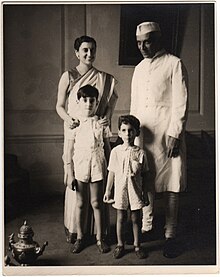The women who ruled in our life time : Indira Ghandi ; 'Someday I am going to lead my people to freedom just as Joan of Arc did!'"
Family, personal life and outlook[edit]
Gandhi's yoga guru, Dhirendra Brahmachari, helped her in making certain decisions and also executed certain top level political tasks on her behalf, especially from 1975 to 1977 when Gandhi "declared a state of emergency and suspended civil liberties."[188][189]
Views on women[edit]
In 1952 in a letter to her American friend Dorothy Norman, Gandhi wrote: "I am in no sense a feminist, but I believe in women being able to do everything...Given the opportunity to develop, capable Indian women have come to the top at once." While this statement appears paradoxical, it reflects Gandhi's complex feelings toward her gender and feminism.[191] Her egalitarian upbringing with her cousins helped contribute to her sense of natural equality. "Flying kites, climbing trees, playing marbles with her boy cousins, Indira said she hardly knew the difference between a boy and a girl until the age of twelve.",[192][193]Indira Gandhi did not often discuss her gender, but she did involve herself in women's issues before becoming the prime minister. Before her election as the Prime Minister, she became active in the organizational wing of the Congress party, working in part in the Women's Department.[194] In 1956, Gandhi had an active role in setting up the Congress Party's Women's Section.[195] Unsurprisingly, a lot of her involvement stemmed from her father. As an only child, Gandhi naturally stepped into the political light. And, as a woman, Gandhi naturally helped head the Women's section of the Congress Party. She often tried to organize women to involve themselves in politics[citation needed]. Although rhetorically Gandhi may have attempted to separate her political success from her gender, Gandhi did involve herself in women's organizations. The political parties in India paid substantial attention to Gandhi's gender before she became prime minister, hoping to use her for political gain[citation needed]. Even though men surrounded Gandhi during her upbringing, she still had a female role model as a child. Several books on Gandhi mention her interest in Joan of Arc. In her own accounts through her letters she wrote to her friend Dorothy Norman, in 1952 she wrote: "At about eight or nine I was taken to France; Jeanne d'Arc became a great heroine of mine. She was one of the first people I read about with enthusiasm."[196] Another historian recounts Indira's comparison of herself to Joan of Arc: "Indira developed a fascination for Joan of Arc, telling her aunt, 'Someday I am going to lead my people to freedom just as Joan of Arc did!'"[197] Gandhi's linking of herself to Joan of Arc presents a nice model for historians to assess Gandhi. As one writer said: "The Indian people were her children; members of her family were the only people capable of leading them."[198]
Gandhi had been swept up in the call for Indian independence since she was born in 1917.[199] Thus by 1947 she was already well immersed in politics, and by 1966, when she first assumed the position of prime minister, she had held several cabinet positions in her father's office[citation needed].
Gandhi's advocacy for women's rights began with her help in establishing the Congress Party's Women's Section[citation needed]. In 1956, she wrote in a letter: "It is because of this that I am taking a much more active part in politics. I have to do a great deal of touring in order to set up the Congress Party Women's Section, and am on numerous important committees."[195] Gandhi spent a great deal of time throughout the 1950s helping organize women. She wrote to Norman in 1959, irritable that women had organized around the communist cause but had not mobilized for the Indian cause: "The women, whom I have been trying to organize for years, had always refused to come into politics. Now they are out in the field."[200] Once appointed president in 1959, she "travelled relentlessly, visiting remote parts of the country that had never before received a VIP...she talked to women, asked about child health and welfare, inquired after the crafts of the region"[201] Gandhi's actions throughout her ascent to power clearly reflect a desire to mobilize women[citation needed]. Gandhi did not see the purpose of feminism. Gandhi saw her own success as a woman, and also noted that "Given the opportunity to develop, capable Indian women have come to the top at once."[191]
Gandhi felt guilty about her inability to fully devote her time to her children. She noted that her main problem in office was how to balance her political duties with tending to her children, and "stressed that motherhood was the most important part of her life."[202] At another point, she went into more detail: "To a woman, motherhood is the highest fulfilment…To bring a new being into this world, to see its perfection and to dream of its future greatness is the most moving of all experiences and fills one with wonder and exaltation."[203]
Her domestic initiatives did not necessarily reflect favourably on Indian women. Gandhi did not make a special effort to appoint women to cabinet positions. She did not appoint any women to full cabinet rank during her terms in office.[96] Yet despite this, many women saw Gandhi as a symbol for feminism and an image of women's power.[96]



Comments
Post a Comment